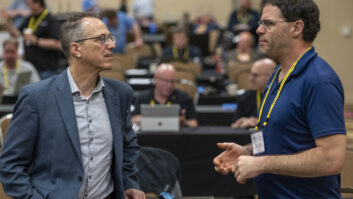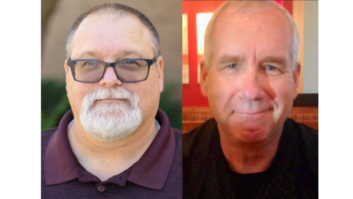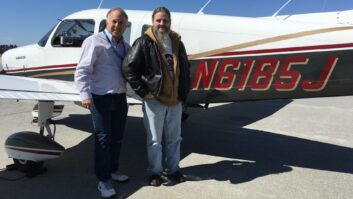
iStockphoto In last month’s issue, Diana Stokey tested your broadcast engineering knowledge with our quiz. Compare your answers here to see how you did — and don’t forget to let Radio World know your score. Write to us at [email protected].
1. What is Raspberry Pi?
It is a credit card-sized computer board, designed to encourage a new generation of PC users to discover and develop their programming skills. When connected to a monitor/TV and keyboard, with the right programming by the user, it can be used for many things that your traditional PC does. It’s not a simple plug-and-play PC. It doesn’t have Windows or similar packages installed, so it isn’t a like-for-like replacement for a normal laptop or desktop computer.
2. If a Fresnel zone is not clear of obstacles, what can be the effect on signal transmission?
Phase cancellation, which reduces the power of the arriving signal.
3. What general factors determine Effective Radiated Power?
Transmitter power, antenna gain, any losses such as in transmission line.
4. What is NEMO?
The acronym is often said to mean Not Emanating from Main Office in the world of telco. But nemo came to be used in early radio to refer to remote broadcasts, and historian Donna Halper has written that it was an accidental exclamation by an engineer at WEAF.
5. How many different amplitude levels can be represented in a 32-bit audio sample?
c) 4,294,967,296
6. What is the punch-down color code order for a TIA-568B wiring interconnect cable?
White with Orange Stripe
Orange with White Strip
White with Green Stripe
Blue with White Stripe
White with Blue Stripe
Green with White Stripe
White with Brown Stripe
Brown with White Stripe
(Ordered from pin 1– 8)
7. What does ASRN stand for and what is it?
Antenna Structure Registration Numbers — The ASR program requires owners of antenna structures to register with the FCC (and receive a registration number) any antenna structure that requires notice of proposed construction to the Federal Aviation Administration. In general, this includes structures that are taller than 200 feet above ground level or that may interfere with the flight path of a nearby airport. The antenna structure owner must obtain painting and lighting specifications from the FAA and include those specifications in its registration prior to construction. The ASR program allows the FCC to fulfill its statutory responsibility to require painting and lighting of antenna structures that may pose a hazard to air navigation.
8. What property can be defined as the orientation of the electric field wave as it propagates away from an antenna?
Polarization.
9. A wattmeter in a transmission system indicates there is 50,000 watts of forward power going up the line and 25 watts being reflected back to the transmitter. What is the return loss?
33.01 dB.
10. A foam-filled transmission line has the following characteristics: inductance per unit length = 0.2594µH, capacitance per unit length = 98.65 pF. What formula should be used to solve for the speed at which electromagnetic waves propagate through the line? What is the speed?
The formula for solving is V = 1/(LC)1/2 197,681,701 m/s. (That is meters per second.)
11. What is AVWS?
a) Audio Visual Warning System — It is an all-weather, day and night, low-voltage, radar-based obstacle avoidance system that utilizes current obstruction lighting products and does not require additional equipment in an aircraft. AVWS activates obstruction lighting and audio signals to alert pilots of potential collisions with obstacles such as power lines, wind turbines, bridges, and towers. The obstruction lights and audio warnings are inactive when there is no air traffic in the area of the obstruction.
12. Some FM antennas are tuned by placing a piece of dielectric material at a strategic location near the antenna to match the antenna to the line and transmitter. Why do we not just add this material at the input of the line to match the transmitter and avoid climbing the tower?
Reflections from the mismatched antenna down the length of the transmission line would increase the power loss each time a reflection propagated up and down the line. If the matching is done at the antenna, transmission line loss is not a contributing factor to loss due to the mismatch.
13. What is “angry IP” used for?
The Angry IP app will scan every IP address to see if they are active, as well as the name of the computer using the IP address and the user who is accessing it.
14. How is null fill generally achieved in multi-element side-mounted FM antennas?
Adjusting power distribution between elements.
15. A circle of a given diameter centered on the normalized locus of a Smith chart represents what quantity(s)?
SWR Circle
16. Using a Smith chart, determine the input impedance seen at the input of a 108° lossless line having a characteristic impedance of 50Ω terminated in an impedance of 80+j40Ω.
b) 23 j0
17. What are two of the most common uses for a quarter wave 3 dB hybrid?
c) Splitters and combiners
18. How is beam tilt generally achieved in multi-element side-mounted FM antennas?
Phase shift between antenna elements, normally done with the length of interbay lines on and end fed antenna. On a center feed, the feed point is offset or moved up.
19. Some FM antenna manufacturers use steatite as a dielectric material for slug tuning while others use brass. Why might steatite be considered superior to brass for this purpose?
It does not significantly impact voltage rating of the transmission line because steatite does not conduct.







